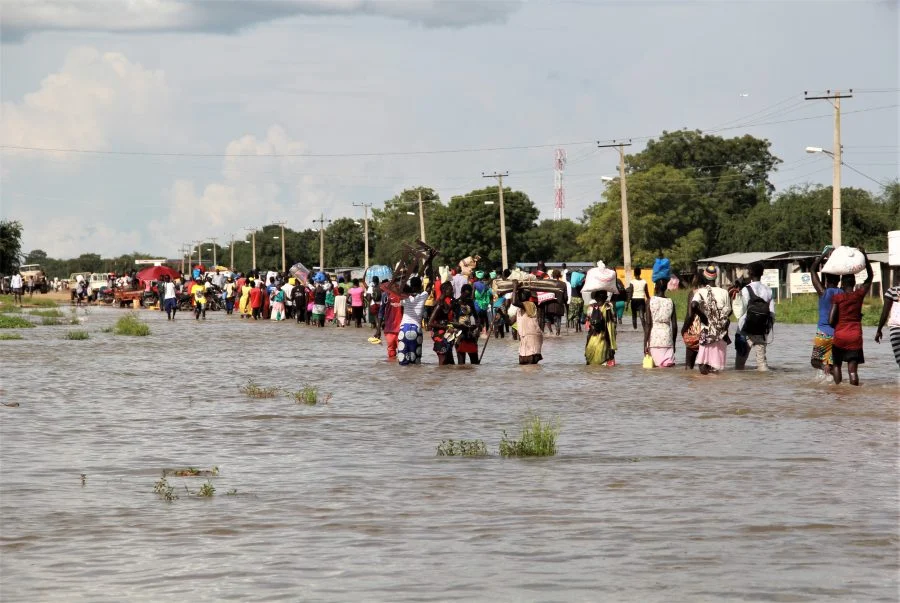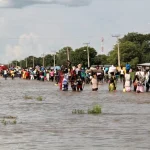For environmental and climate scientists, a triple crisis threatens the planet: climate change, biodiversity loss, and pollution. This crisis endangers the entire planet, with developing countries being the most at risk. Numerous international reports on climate change and its impacts warn that Sudan, in particular, could become the first country to vanish due to climate change driven by global warming.
In a statement to CNN, chemist scientist Jos Lelieveld, a researcher at the Max Planck Institute for Chemistry, said: “North Africa is already hot, and temperatures there continue to rise. At some point this century, parts of this region will become uninhabitable, spanning from Morocco to Saudi Arabia.”
A recent study conducted by Dr. Rehab Mohamed Al-Hassan, coordinator of the Third National Communication Project for the Climate Change Convention, found that between 1970 and 2004, greenhouse gas emissions increased by 70% compared to pre-industrial levels. The Internal Displacement Monitoring Centre (IDMC) notes that irregular rainfall has destroyed crops, leaving Sudan to grapple with droughts and floods that render land unfit for farming. Between 2013 and 2018, over 600,000 people were displaced due to flood-related crises.
Dr. Moatasem Nimir, head of the Sudanese Society for Environmental Protection, reported that temperatures have risen by 2.1°F over the past century and are projected to increase by 8.6°F over the next hundred years.
In a scientific paper authored by Dr. Abdelilah Mohamed Al-Hassan Abdelsalam, Dean of the Faculty of Health and Environmental Sciences at Gezira University, Sudan (published in the Assiut Journal of Environmental Studies, January 2009), he discusses the environmental and climatic impacts on Sudan. He predicts an 80% reduction in sorghum yields in western Sudan, leading to a food crisis and mass migration. He also highlights that Sudan, which produces 85% of the world’s gum arabic—a key crop—might see a 25-30% drop in production, negatively impacting GDP and the economy. Health impacts, such as increased malaria transmission rates between October and December, are also anticipated. Desertification is causing soil nutrient depletion and increased dust storms, which lead to air pollution. The loss of vegetation is further reducing crop yields, particularly of sorghum, a staple food in Kordofan and Darfur in western Sudan.
A joint report by the Ministry of Agriculture and Forestry and the World Bank (2016) indicates that 65% of Sudan’s population relies on agriculture, which contributes 30–35% of the national income. According to the Food and Agriculture Organization (FAO, 2018), 50% of Sudan’s workforce is employed in agriculture.
Sudan’s climate is changing with rising temperatures, fluctuating rainfall patterns, and increasing frequency of droughts and floods. The country heavily relies on fossil fuels for energy (wood, charcoal, agricultural, and animal waste), which exposes people to various forms of pollution. The UNEP report states that 56% of Sudan’s energy comes from fossil fuels, 39% from petroleum products (gasoline, diesel, and heavy oils), and 5% from hydropower.
According to the Meteorological Authority (2019), temperatures range from 41–47°F, which is extremely high. The combination of drought and desert conditions creates ideal conditions for dust storms, a major source of air pollution.
Deserts cover 72% of Sudan, while only 21.3% of its 216 million arable acres are utilized, according to the Ministry of Agriculture and Forestry (2018). FAO data shows that Sudan’s vegetation cover has shrunk from 40% in 1950 to 27% in the early 2000s and just 10.3% in 2015. Notably, a third of the country’s area was lost following South Sudan’s secession in 2011.
Attila Orsal, the UN Environment Program’s country director, noted that the desert has expanded southward by about 200 kilometers, advancing 4–5 kilometers annually. The unprecedented rise in the Blue Nile’s water levels, unseen in a century, caused floods that impacted 17 of Sudan’s 18 states. In a country heavily dependent on natural resources, environmental impacts risk compromising peace, access to water, food security, public health, and livelihoods.
The studies and scientific papers cited above were conducted before the outbreak of the April 15, 2023, war. Environmental degradation in Sudan had already reached alarming levels despite a stable central government and ongoing local conflicts. Regions such as eastern Sudan and the northern states faced severe floods during last year’s rainy season amidst the state’s absence and its institutions’ preoccupation with war. Environmental deterioration is expected to worsen further without any mechanisms to address the rapidly accelerating degradation.
Many areas within the war zone have seen a near-total halt in agricultural activities, significant vegetation loss, and insufficient conditions for accurate measurements. The war itself has introduced problems, with thousands of corpses abandoned on roads and hundreds dumped into the Nile River. This creates grave environmental issues that could severely impact public health, leading to the spread of diseases, epidemics, and potential deaths. Vulnerable groups, including children, the elderly, pregnant women, individuals with chronic illnesses, and people with disabilities, face the highest risks.





